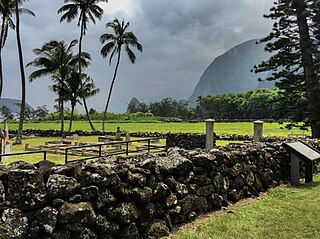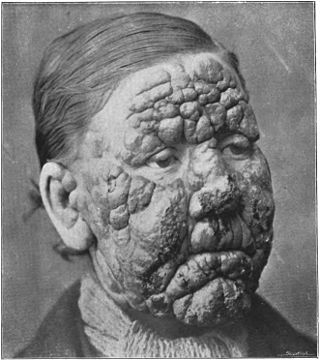
Leprosy, also known as Hansen's disease (HD), is a long-term infection by the bacteria Mycobacterium leprae or Mycobacterium lepromatosis. Infection can lead to damage of the nerves, respiratory tract, skin, and eyes. This nerve damage may result in a lack of ability to feel pain, which can lead to the loss of parts of a person's extremities from repeated injuries or infection through unnoticed wounds. An infected person may also experience muscle weakness and poor eyesight. Leprosy symptoms may begin within one year, but, for some people, symptoms may take 20 years or more to occur.

Molokai is the fifth most populated of the eight major islands that make up the Hawaiian Islands archipelago in the middle of the Pacific Ocean. It is 38 by 10 miles at its greatest length and width with a usable land area of 260 sq mi (673.40 km2), making it the fifth-largest in size of the main Hawaiian Islands and the 27th largest island in the United States. It lies southeast of Oʻahu across the 25 mi (40 km) wide Kaʻiwi Channel and north of Lānaʻi, separated from it by the Kalohi Channel.

A leper colony, also known by many other names, is an isolated community for the quarantining and treatment of lepers, people suffering from leprosy.
M. leprae, the bacterium responsible for leprosy, is believed to have spread from East Africa through the Middle East, Europe, and Asia by the 5th century before reaching the rest of the world more recently. Historically, leprosy was believed to be extremely contagious and divinely ordained, leading to enormous stigma against its sufferers. Other severe skin diseases were frequently conflated with leprosy and all such sufferers were kept away from the general public, although some religious orders provided medical care and treatment. Recent research has shown M. leprae has maintained a similarly virulent genome over at least the last thousand years, leaving it unclear which precise factors led to leprosy's near elimination in Europe by 1700. A growing number of cases following the first wave of European colonization, however, led to increased attention towards leprosy during the New Imperialism of the late 19th century. Following G.A. Hansen's discovery of the role of M. leprae in the disease, the First International Leprosy Conference held in Berlin in 1897 renewed interest and investment in the isolation of lepers throughout the European colonial empires. Although Western countries now generally treat cases of leprosy individually on an outpatient basis, traditional isolated colonies continue to exist in India, China, and some other countries.

Marianne Cope, OSF, was a German-born American religious sister who was a member of the Sisters of St. Francis of Syracuse, New York, and founding leader of its St. Joseph's Hospital in the city, among the first of 50 general hospitals in the country. Known also for her charitable works, in 1883 she relocated with six other sisters to Hawaiʻi to care for persons suffering leprosy on the island of Molokaʻi and aid in developing the medical infrastructure in Hawaiʻi. Despite direct contact with the patients over many years, Cope did not contract the disease.

Kalaupapa National Historical Park is a United States National Historical Park located in Kalaupapa, Hawaiʻi, on the island of Molokaʻi. Coterminous with the boundaries of Kalawao County and primarily on Kalaupapa peninsula, it was established by Congress in 1980 to expand upon the earlier National Historic Landmark site of the Kalaupapa Leper Settlement. It is administered by the National Park Service. Its goal is to preserve the cultural and physical settings of the two leper colonies on the island of Molokaʻi, which operated from 1866 to 1969 and had a total of 8500 residents over the decades.

Peel Island is a small heritage-listed island located in Moreton Bay, east of Brisbane, in South East Queensland, Australia. The island is a locality within the local government area of Redland City and a national park named Teerk Roo Ra National Park and Conservation Park.

Losheng Sanatorium is a sanatorium for lepers in Xinzhuang District, New Taipei, Taiwan. Losheng means "happy life". The building was constructed in the 1930s during the Japanese colonial period.
Matsuo Fujimoto was a Japanese man charged for a 1952 murder and executed by hanging in 1962. His guilty verdict, death sentence, and execution were controversial, because he suffered from leprosy and the Japanese government discriminated against people with leprosy at that time.
Leprosy stigma is a type of social stigma, a strong negative feeling towards a person with leprosy relating to their moral status in society. It is also referred to as leprosy-related stigma, leprostigma, and stigma of leprosy. Since ancient times, leprosy instilled the practice of fear and avoidance in many societies because of the associated physical disfigurement and lack of understanding behind its cause. Because of the historical trauma the word "leprosy" invokes, the disease is now referred to as Hansen's disease, named after Gerhard Armauer Hansen who discovered Mycobacterium leprae, the bacterial agent that causes Hansen's disease. Those who have suffered from Hansen's disease describe the impact of social stigma as far worse than the physical manifestations despite it being only mildly contagious and pharmacologically curable. This sentiment is echoed by Weis and Ramakrishna, who noted that "the impact of the meaning of the disease may be a greater source of suffering than symptoms of the disease".
As of 2009, 2,600 former leprosy patients were living in 13 national sanatoriums and 2 private hospitals in Japan. Their mean age is 80. There were no newly diagnosed Japanese leprosy patients in 2005, but one in 2006, and one in 2007.
Masasue Suō was a Japanese physician, the director of the Sorok Island Sanatorium in Korea. He completed the world's biggest leprosy facility, Sorok Island Sanatorium, hospitalizing 6000 patients. He was assassinated by a patient while rushing to a morning ceremony. Forced segregation of leprosy patients, inhumane treatments towards patients, and antipathy against colonial rule were behind the assassination.
Leper colony money was special money which circulated only in leper colonies due to the fear that money could carry leprosy and infect other people. However, leprosy is not easily transmitted by casual contact or objects; actual transmission only happens through long-term, constant, intimate contact with leprosy sufferers and not through contact with everyday objects used by sufferers.

Worldwide, two to three million people are estimated to be permanently disabled because of leprosy. India has the greatest number of cases, with Brazil second and Indonesia third.

Although leprosy, or Hansen's Disease, was never an epidemic in The United States, cases of leprosy have been reported in Louisiana as early as the 18th century. The first leprosarium in the continental United States existed in Carville, Louisiana from 1894-1999 and Baton Rouge, Louisiana is the home of the only institution in the United States that is exclusively devoted to leprosy consulting, research, and training.
The Muraiken Undō, or No Leprosy Patients in Our Prefecture Movement, was a government funded Japanese public health and social movement which began between 1929 and 1934. Its mission was to systematically eliminate leprosy,, a readily transmissible, previously incurable, chronic infectious disease caused by M. leprae, from each prefecture in Japan. This was to be achieved by caring for those affected by the disease in government funded sanatoriums.
There has, historically, been fear around leprosy and people with the disease have suffered stigma, isolation and social exclusion. Expulsion of individuals infected with leprosy to quarantined areas or special institutions has been the general protocol since ancient times and was the recommended course of action by the Leprosy Conference of Berlin 1897. As a result, the exclusion and quarantining of people infected with leprosy became law, hence leprosy colonies were formed. The inhabitants of these colonies had very little legal recourse in preventing their exclusion and, even after they were treated and cured, many had trouble reintegrating into society. Even by the 1960s, when leprosy was highly treatable and curable, it still resulted in repulsion, and the exclusion of sufferers, by the general populace. As leprosy became curable, the focus of study shifted towards investigating the social aspects of the disease. This has become relevant due to the fact that the disease is making a resurgence and is proving resistant to previous remedies.
The Culion leper colony is a former leprosarium located on Culion, an island in the Palawan province of the Philippines. It was established by the U.S. government in order to rid leprosy from the Philippine Islands through the only method known at the time: isolating all existing cases and gradually phasing out the disease from the population. In addition to segregating the disease from the rest of the population, the island was later established in order to offer a better opportunity for people afflicted with leprosy to receive adequate care and modern treatments.

The history of leprosy was traced to its origins by an international team of 22 geneticists using comparative genomics of the worldwide distribution of Mycobacterium leprae. Monot et al. (2005) determined that leprosy originated in East Africa or the Near East and traveled with humans along their migration routes, including those of trade in goods and slaves. The four strains of M. leprae are based in specific geographic regions where each predominantly occurs:

The Carville Historic District in Carville, Louisiana, is a 60-acre (24 ha) historic district that was listed on the National Register of Historic Places on November 18, 1992. It formerly served as a treatment facility for leprosy, and was called the National Leprosarium, Gillis W. Long Hansen's Disease Center and Public Health Service Hospital No. 66.

Bernice Gottlieb is an early leader in the trans-racial adoption movement in the United States. In later years, she led a residential real estate firm and authored several books, including one on adoption.












